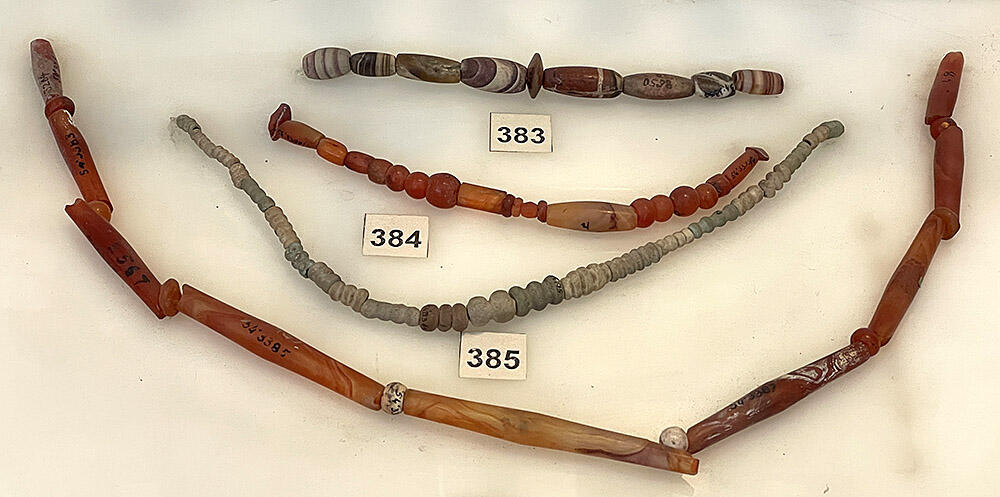The long carnelian beads at the bottom of this image are among the most distinctive products made during the height of the ancient Indus civilization. Dr. Kenoyer writes (Ancient Cities, pp. 162):
"Many of the long carnelian beads were traded as far as Mesopotamia, where they have been found in the burials of the royal cemetery at Ur. Detailed studies of these beads indicate that some of them were made in the Indus Valley, whereas other examples, made with Indus drilling technology and Indus raw materials may have been produced in Mesopotamian styles for Mesopotamian elites. It is possible that these beads were made by migrant Indus artisans residing in Mesopotamia, members of the so-called Meluhhan minority that are documented in Mesopotamian texts.
"The importance of long carnelian beads to Indus ornament styles can only be fully appreciated when compared with the imitations that were made in terracotta (fig. 8.34). Painted with red pigment to look like carnelian, these long terracotta beads, made into long necklaces or chokers, are found in all of the Indus settlements. When worn as a belt or necklace, terracotta beads strike against one another to make a delicate clinking sound, not unlike that produced by the real carnelian beads. In modern Pakistan and India, the sound of ornaments is often referred to in poetry to evoke sensual beauty. and the sound of beads and bangles clinking against one another may have been just as important as the visual symbolism evoked by Indus ornaments."
Sir John Marshall writes (see Image 2 above, Mohenjo-daro, p. 511):
"This type of bead is of unusual interest, as similar beads found at Kish have been dated to the pre-Sargonic Period. [Footnote: Mackay, A Sumerian Palace, etc., pt. ii, pl. xliii, figs. 8 and 9. These carnelian beads I regard as important from the point of view of dating our site. They seem not to have been worn in Babylonia later than c. 2700 B.C., and are aIso unknown in India, as far as I can ascertain, except in the Indus Valley civilization. At Kish the same form of bead was made in lapis-lazuli. Ibid., pl. Ix, Nos. 18 and 19].
"As, however, beads of this type were uncommon in early Mesopotamia and fairly plentiful at Mohenjo-daro, in both the Late and Intermediate Periods, there is reason to think that they were made in India and exported to Mesopotamia. They have apparently not been found in Elam. Beads of this shape were always made of a beautiful translucent red carnelian (Nos. 24-8), or of pottery (Nos. 29-32); the one exception, which, unfortunately, is broken, is of a dark green coloured chalcedony (S 2508), known to geologists as "plasma".
"The pottery beads are probably an imitation of the carnelian beads. They are very roughly made and closely resemble pottery beads of the same shape found at Jemdet Nasr in Mesopotamia, which site is closely dated by its painted pottery to the period of Musyn in Elam. But only pottery beads of this shape were found at Jemdet Nasr; there were none of carnelian. Sometimes these pottery beads are coated with a smooth red slip (PI. CLI, 19, a-c).
"Some difficulty seems to have been experienced in drilling the holes (slightly conical) through these stone beads, which is not to be wondered at considering their length. The boring was done from both ends, and in some cases the two holes did not meet exactly in the middle. All the beads of this type were probably cut and polished before the boring was commenced, for the translucency of the polished stone would naturally help the lapidary to se whether his drill-holes were running straight."




